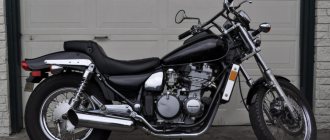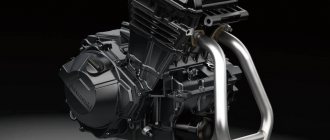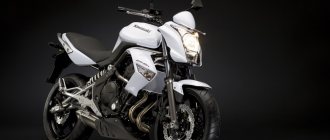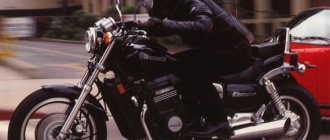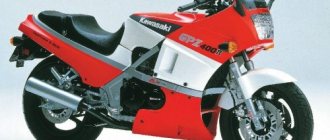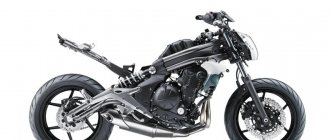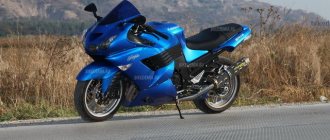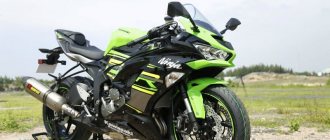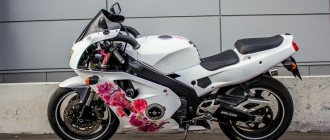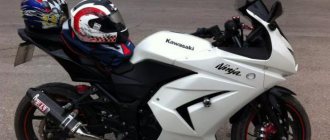| Kawasaki KDX250 (KDX250A) 1980 | Kawasaki KDX250 (KDX250B) 1981-1984 | Kawasaki KDX250 / KDX250R (KDX250E / KDX250D) 1991-1995 | Kawasaki KDX250SR (KDX250F) 1991-1994 |
Kawasaki KDX250 enduro model
begins its history in 1980, when the first generation of a motorcycle was introduced to the market, which was available only in the USA.
That generation was, by today's standards, quite archaic - 2-stroke air-cooled engine, drum brakes and crude plastics. Factory model code is KDX250-A
.
In 1981, the Kawasaki KDX250 underwent minor changes, receiving turn signals and a new plastic design. Factory model code - KDX250-B
. 1984 was the last year of production.
In 1991, Kawasaki resumed production of the KDX250, seriously updating it both externally and technically - a new liquid-cooled engine, disc brakes, and an inverted fork. Starting this year, the model became available not only in the North American market, but also in Europe, Australia and Japan. Now 3 modifications of the motorcycle were offered:
- Kawasaki KDX250R
(KDX250-D) - “hard enduro” modification. It does not have turn signals or a speedometer (it is equipped with a simple trip meter with daily and total mileage). Was available from 1991 to 1995. in Europe, North America and Japan. - Kawasaki KDX250
(KDX250-E) - identical to the previous modification, but with the possibility of use on special stages. Equipped with turn signals and a full speedometer. Existed from 1991 to 1992. in the markets of Europe and Australia. - Kawasaki KDX250SR
(KDX250-F) - “soft-enduro” modification. Was available from 1991 to 1994. only in the Japanese domestic market. It is a previous modification with a number of changes: the presence of mirrors, other suspension and geometry settings, a smaller fuel tank (from 12.5 to 11.0 l), a smaller carburetor (PWK35 instead of PWK38), other gearbox settings, dry weight increased by 9 kg .
1995 was the last year of production of the Kawasaki KDX 250, after which it finally left the market and did not receive further development.
The main competitors of the Kawasaki KDX 250 in the class:
- Honda CRM 250
- Suzuku RMX 250 S
Brief history of the model
- 1980 - start of production and sales. First generation.
Model
: Kawasaki KDX250 (North America).
Factory designation:
KDX250-A1.
- 1981 - restyling of the model. Second generation.
Model
: Kawasaki KDX250 (North America).
Factory designation:
KDX250-B1.
- 1982 - no significant changes.
Model
: Kawasaki KDX250 (North America).
Factory designation:
KDX250-B2.
- 1983 - no significant changes.
Model
: Kawasaki KDX250 (North America).
Factory designation:
KDX250-B3.
- 1984 - no significant changes.
Model
: Kawasaki KDX250 (North America).
Factory designation:
KDX250-B4.
- 1991 - restyling of the model. Third generation
. The emergence of new modifications and expansion of sales markets.
Model
: Kawasaki KDX250;
Kawasaki KDX250R; Kawasaki KDX250SR (North America, Europe, Australia, Japan). Factory designation:
KDX250-E1; KDX250-D1; KDX250-F1.
- 1992 - no significant changes.
Model
: Kawasaki KDX250;
Kawasaki KDX250R; Kawasaki KDX250SR (North America, Europe, Australia, Japan). Factory designation:
KDX250-E2; KDX250-D2; KDX250-F2.
- 1993 - The KDX250-E modification is no longer offered.
Model
: Kawasaki KDX250R;
Kawasaki KDX250SR (North America, Europe, Japan). Factory designation:
KDX250-D3; KDX250-F3.
- 1994 - no significant changes.
Model
: Kawasaki KDX250R;
Kawasaki KDX250SR (North America, Europe, Japan). Factory designation:
KDX250-D4; KDX250-F4.
- 1995 - SR modification is no longer offered. Last year of production of the R-modification.
Model
: Kawasaki KDX250R (Europe).
Factory designation:
KDX250-D5.
Motorcycle Kawasaki KDX 250 1981 review
Technical specifications Kawasaki KDX 250 1981
Engine Kawasaki KDX 250 1981
Transmission Kawasaki KDX 250 1981
Dimensions and weights of Kawasaki KDX 250 1981
Chassis and brakes Kawasaki KDX 250 1981
Dynamic characteristics of Kawasaki KDX 250 1981
Other characteristics of Kawasaki KDX 250 1981
Description Kawasaki KDX 250 1981
Description of the Kawasaki KDX 250 1981 motorcycle is in the queue for publication of the article. Announcement: Today, for almost every new motorcycle that comes into being, marketers strive to carve out their own niche. This one is a road sport, this one is a recreational enduro. But what class should we include a motorcycle that has a little bit of everything? A good bike should have a reliable engine, comfortable ergonomics and simple controls.
Despite the fact that good models of motorcycles have a very respectable price, and the season for their use is relatively short, the motorcycle market is developing rapidly. And if you believe the words of dealers, then some models of recently released motorcycles are selling like hot cakes at the beginning of the season, and the models brought to Russia are clearly not enough to fully satisfy consumer demand.
A motorcycle has long ceased to be an alternative to a car, and the times when this equipment was bought only because there was not enough money for a full-fledged car are forgotten. Nowadays, two-wheelers can be called technological marvels in many cases, and their cost can be compared with that of prestigious cars.
Many people have started buying motorcycles for hobby purposes as riding or even collecting them has become a good pastime for many people. Many motorcycles, for example the Kawasaki KDX 250, whose technical characteristics make it possible to call the model a prestigious brand, are in demand among both beginners and experienced motorcyclists.
Currently, it is impossible to purchase a new Kawasaki KDX 250 motorcycle from the 1981 model year, since their production stopped 35 years ago. At the same time, the Kawasaki KDX 250 has excellent technical characteristics, so many people strive to purchase, if not a new, then at least a used version.
Motorcycles with an engine capacity of 249 cc. see, appeared as a result of long work of inventors who sought to create a model that was not inferior in characteristics to other versions of the motorcycle. In some cases, these models are not only not inferior, but also ahead of other motorcycles, as they have minimal fuel consumption and other excellent parameters.
The Kawasaki KDX 250 belongs to a common class of motorcycles with an engine capacity of 125 to 250 kb. cmAs a rule, these are light and relatively low-power motorcycles. Here you will get flexible control, easy steering and low weight of the motorcycle. Therefore, such motorcycles are suitable for almost every beginner, regardless of their characteristics. The exception is motorcycles with two-stroke engines of the “sport” and “cross” classes, since bikes of this class are distinguished by more power and an extremely sharp response to the throttle, which also does not make them obedient to control.
Go to the entire range of Kawasaki motorcycles, on this page you can find Kawasaki KDX 250 motorcycles from other years of production and information about them
Motorcycles similar in characteristics to the KDX 250:
Showing similar motorcycles with a limit of 5 pieces, see all similar to KDX 250
Kawasaki KDX 250 price based on sales advertisements
* Attention! Under the maximum, average and minimum of the Kawasaki KDX 250 motorcycle on this page, the average cost according to advertisements for sale on the Internet is indicated, without taking into account the year of manufacture, configuration and generation of the motorcycle model.
Kawasaki KDX 250 sales statistics by regions of the Russian Federation (in the form of shares)
- Ryazan region 4.08%
- Krasnodar region 19.39%
- Moscow region 6.12%
- Orenburg region 5.10%
- Samara region 3.06%
- Stavropol Territory 3.06%
- St. Petersburg 4.08%
- Primorsky Krai 6.12%
- Chelyabinsk region 3.06%
- Sverdlovsk region. 5.10%
- Kamchatka Territory 3.06%
Five random motorcycles:
Five random articles about motorcycles:
40000 km to Java 634-8-00
CORRECT BREAK-IN IS THE KEY TO DURABILITY IN A COLD ENGINE WITH INTENSIVE WEAR HIGH SPEED - IT IS EASIER TO MAINTAIN THE ENGINE - YOU REPAIR LESSLY When purchasing a motorcycle of a new brand, a person is naturally interested in everything that concerns this machine. What should you pay attention to when running in, what are the features of driving and maintenance, what is the durability of the main components and assemblies, etc.? These questions are often found in letters from readers. The answers to them are contained in the material published here about the Jawa-350, but much of it is also true for other motorcycles with a two-stroke engine (Voskhod, IZH, etc.). It was prepared by an experienced motorcyclist, consultant to the magazine, engineer E. Konop. We started operating the Jawa-350 type 634 model 8-00 four years ago, rode in a wide variety of conditions, under various loads, in all imaginable modes. Then, in the spring of 1977, the JAVA we took out of the box was no different from the many others that were in Ma’s yard.
Java 250 Trial – Jawa 250 Trial
A trial for everyone Jawa 250 Trial The design of the motorcycle Jawa 250 Trial The Trial is a motorcycle competition for cross-country driving skills that is gaining more and more popularity in the world. At the FIM congress, the issue of making trials the number one discipline in the international motorsports calendar and recommending it to the Olympic Games program was even discussed. In mass trials competitions, excluding official meetings held under the auspices of the FIM, ordinary road motorcycles are used. The modifications boil down to protecting the engine from below, reducing the fork travel and adjusting the motor to achieve maximum power in the first two or three gears (speed does not matter here). At the same time, leading foreign motorcycle companies began producing special machines for trials. The Czechoslovak JAVA plant in Prague is also starting to produce such motorcycles. The design of the Jawa 250 Trial motorcycle takes into account the specifics determined by the competition route. The chassis is provided by the poppy.
Owners of IZH Jupiter 4K. Tighten the screws securing the crank chamber covers
For owners of IZH Jupiter 4K On the IZH-Jupiter-4K motorcycle, after two years of operation, engine performance began to deteriorate: it was difficult to start, and the left cylinder failed at times. When something rattled in it one day, I had to get home in tow. Having disassembled the engine, I saw that the screws securing the crank chamber covers had come loose - they had been precariously sealed at the factory. I tightened the screws and secured them properly. After assembly, the engine began to start and work very well, even at the lowest speeds. Later, a similar defect arose on a friend’s car, and we eliminated it in the same way. Obviously the plant needs to pay attention to this unit.A. ZHMYKHOVKurgan region, r. p. Vargashi1986N01P33
Motorcycle IZH Jupiter 4
Jupiter of the fourth generation The team of the Izhmash production association completed the tenth five-year plan with a double labor victory: a new mechanical assembly building was put into operation, where the production of IZH-Jupiter-4 motorcycles was mastered. “Jupiter-4” is distinguished by a successful combination of the best solutions, tested both on its previous models, as well as on Planet-Sport. The ENGINE has undergone further modernization. Thanks to improved filling and changes in the design of the purge channels, its maximum power has been increased from 25 to 28 hp. s., and torque - from 3.23 to 3.58 kgf.m. In this regard, an additional pair of discs was introduced into the CLUTCH. The FRAME is also interchangeable with previous Jupiter models. The changes affected only the mounting of the gas tank, where rubber shock absorbers were used to reduce vibrations. The shape of the tank has become more modern, and the factory emblem also looks new. IN THE CHASSIS thanks to the modernization of the front.
Boosting the IZH Planet motorcycle. How to increase power
How to increase power The All-Union Spartakiad in technical sports has ended. Motorcycle enthusiasts who have become involved in the sport are interested in ways to increase engine power. In issue No. 10 of our magazine for 1965, factory designers talked about boosting the engines of the Riga-1 moped, Kovrovets-175 and M-103 motorcycles. Now we asked the leading designer of the TsKEB motorcycle industry, K.V. Statsenko, to acquaint motorcyclists with the boost of the IZH-Planet motorcycle. The method he proposes was developed for production machines of the Izhevsk Machine-Building Plant. It differs in that the service life of the engine is not reduced with this method, and it operates in the most favorable conditions. You can increase the engine power of the IZH Planet motorcycle from 13 to 18 hp. With. To do this, you need to slightly change the piston, cylinder head, cylinder, carburetor, air cleaner and exhaust pipes, and in addition, re-make the carburetor pipe and mufflers. Rice. 1.
Specifications
Technical characteristics of Kawasaki KDX250R / KDX250SR:
| Model | Kawasaki KDX250 |
| Motorcycle type | enduro |
| Year of issue | 1980-1995 |
| Frame | steel half-duplex |
| engine's type | 1-cylinder, 2-stroke |
| Working volume | 249 cm³ |
| Bore/Stroke | 67.4 x 70.0 mm |
| Compression ratio | 8.7:1 |
| Cooling | liquid |
| Number of valves per cylinder | power valve system (KIPS) |
| Fuel supply system | Carburetor, 1x Keihin PWK38 – KDX250R Carburetor, 1x Keihin PWK35 – KDX250SR |
| Ignition type | CDI |
| Maximum power | 40.0 hp (29.4 kW) at 7000 rpm – KDX250R 39.0 hp (28.7 kW) at 7500 rpm – KDX250SR |
| Maximum torque | 40.2 Nm (4.1 kg*m) at 6500 rpm – KDX250R 38.2 Nm (3.9 kg*m) at 7000 rpm – KDX250SR |
| Clutch | Multi-disc in oil bath, cable drive |
| Transmission | 5-speed |
| type of drive | chain |
| Front tire size | 80/100-21 51M – KDX250R 80/100-21 51P – KDX250SR |
| Rear tire size | 110/100-18 64M – KDX250R 4.60-18 63P – KDX250SR |
| Front brakes | 1 disc, 220 mm, 2-piston caliper |
| Rear brakes | 1 disc, 190 mm, 1-piston caliper |
| Front suspension | Inverted fork, travel - 300 mm |
| Rear suspension | Pendulum progressive Uni-Trak with monoshock absorber, travel - 310 mm |
| Motorcycle length | 2165 mm – KDX250R 2185 mm – KDX250SR |
| Motorcycle width | 850 mm |
| Motorcycle height | 1250 mm – KDX250R 1220 mm – KDX250SR |
| Wheelbase | 1475 mm – KDX250R 1455 mm – KDX250SR |
| Seat height | 955 mm – KDX250R |
| Minimum ground clearance (clearance) | 340 mm – KDX250R 300 mm – KDX250SR |
| Acceleration 0-100 km/h (0-60 mph) | |
| Maximum speed | |
| Gas tank capacity | 12.5 l – KDX250R 11.0 l – KDX250SR |
| Motorcycle weight (dry) | 107 kg – KDX250R 116 kg – KDX250SR |
Kawasaki KDX 250 - a distinctive enduro from the last century
This is a distinctive enduro from the last century. The Kawasaki KDX 250 is a vehicle for serious riding in wild and not so wild places, capable of covering long distances.
This applies to the entire enduro class, in which this Kawasaki motorcycle, although not the best, occupies a prominent place.
Appearance
The Kawasaki KDX 250 looks like a typical enduro. Colors vary, but the color usually appears is green. The light green bike with a blue seat and shock absorbers looks especially impressive. The front light is small and square, like enduro and supermoto.
Spoke wheels make the bike lighter. The front wheel is slightly larger than the rear. The details are clearly visible, which gives the bike a unique effect. However, the frame covers a significant part. There are many similarities between the appearance of the KDX 250 and motocross bikes.
Comfort
The motorcycle is convenient primarily for those who like to travel to places with not very good roads or without them. A tourist or, especially, a sports-tourist option is not suitable here. And enduro copes well with mud and other difficulties of wild places.
Of course, you won’t be able to take anything with you other than a backpack. But with a competent approach to motorcycle tourism, nothing else is needed. It is important that you have at least two GPS navigators with you, and that the route is thoroughly thought out. Otherwise, the bike is convenient, including maintenance and searching for spare parts.
Dimensions and weight
In terms of dimensions, this bike meets class standards. Weight, ground clearance, wheelbase - all this makes the motorcycle excellently passable and controllable in wild and difficult conditions. But we can’t say that this is a special advantage of a particular model, because most other enduros have the same dimensions.
Dimensions and weight are:
- height – 1250 mm;
- width – 850 mm;
- length – 2165 mm;
- wheelbase – 1475 mm;
- seat height – 955 mm;
- ground clearance - 340 mm;
- curb weight – 116 kg;
- Tank capacity – 12.5 l.
The fuel tank capacity will last a long time, although it is small. So it is important to make sure that you come across gas stations on time along the route, because there will be no other opportunity to refuel the tank on such a trip.
Specifications
According to these parameters, the bike is not inferior to many others, although it is not advanced. It is important to remember the time when it was produced and make allowances when comparing with current enduro representatives. However, even today, in terms of technical characteristics, the car remains competitive with weak current models.
| Motor type | in-line, 1 cylinder, 2 stroke |
| Power | 40 hp |
| Torque | 40.2 Nm |
| Maximum speed | 180 km/h |
| Acceleration to 100 | 7.1 s |
| Fuel consumption per hundred | 7 l |
| Drive unit | chain |
| Transmission | five-speed |
| Frame | half-duplex steel |
| Rear suspension | pendulum, monoshock absorber, stroke 310 mm |
| Front suspension | inverted fork, 300 mm travel |
| Rear brakes | 1 disc, 190 mm, 1-piston caliper |
| Front brakes | 1 disc, 220 mm, 2-piston caliper |
Such parameters make this bike suitable for those who want to try off-road riding, but are wary of some powerful motocross bike. Also, connoisseurs of old representatives of the class will appreciate how the car is made and the path it has traveled.
Production
Production began back in 1980. Then, of course, it was a car that was interesting to many. The technical parameters of this motorcycle at that time were very good.
The production lasted a long time and ended only in 1995. Of course, this is not the most striking example of longevity on the assembly line, but still, fifteen years of history is a considerable period.
Classmates
Perhaps the main competitor of the model is the RMX 250 S from Suzuki. However, the CRM 250 from Honda also competes.
Both bikes more or less correspond to Kawasaki in terms of technical parameters, and it is impossible to say which machine is definitely worse and which is better.
History of changes
There have been few changes, but this is good, because it speaks about the quality of the bike. This means that the equipment was originally designed in such a way that almost nothing had to be modified. Those changes that have been made are more likely to be cosmetic. However, these are also important to note.
Here's the evolution of the Kawasaki KDX 250:
- In 1981 there was a restyling. Since then, the model is already considered the second generation.
- In 1991, the third generation saw the light. There was a new restyling, and a couple of modifications arose.
- In 1995, the last year of production, all modifications were no longer offered.
The fact that production stopped is natural given the development of technology. Updating an enduro, sport bike or even road motorcycles to a modern, up-to-date state is not easy, because it is much cheaper and more expedient to release a new motorcycle from scratch that keeps up with modern times.
What do the owners say?
The motorcycle is reliable, which is clear from the photos and videos. Most owners agree with this. However, someone notes that among all the enduros he has tried, this is not the most reliable.
According to the descriptions of those who have been traveling this way for a long time, the bike usually does not fail, but they still do not advise traveling far from civilization.
Judging by the reviews, it is possible to get good used equipment, but it is important to carefully read the documents. It is advisable to apply all modern methods of checking the condition of the bike to make sure that the machine is well preserved. If the equipment looks good on the outside, this does not mean anything.
Also, one review or another notes that this motorcycle is easy to buy. About 100 thousand Russian rubles – that’s how much such a model costs. The car is praised for its handling and ease of use, but few people called this option the best in the enduro class.
In conclusion, the Kawasaki KDX 250 is the choice for those who want to travel alone and without luggage. The bike is reliable and comfortable, although the best results at the end of the twentieth century were, of course, achieved by Honda. In any case, the machine from Kawasaki is not bad and is still capable of competing with current models.
Reviews
Reviews about Kawasaki KDX 250:
Expand Collapse
Normal device. I had an '89 KDX 200SR. Very smooth thrust for 2T, due to power valves at the exhaust. It's great at the top too! The frame and chassis are in principle indestructible; everything worked on the 1989 vehicle. “SR” is a domestic Japanese model; it is distinguished by the presence of a separate lubrication system, tidy, normal lighting and turn signals. So just what you need. It is possible both on shit roads and on public roads. I myself used it for “dacha racing”. Among the problem areas, these same power valves periodically become clogged with carbon deposits and stop working. In general, sometimes they require maintenance. Models after '94 are less susceptible to this problem. When purchasing, you should pay special attention to the piston! Because These bikes, as a rule, are far from new. And the boiler is made of aluminum with nikasil, which, although reliable, does not last forever. It cannot be repaired; in principle, you can buy a new boiler, but it costs as much as a cast-iron bridge! I don’t remember any other weak points...
2T 250 ENDURO BOOST and SEASON REPORT
Greetings! In this post I’ll talk about the 2t18 season on the Kawasaki KDX250 (no longer SR lol) and explain why there haven’t been any posts since installing the hydraulic clutch on the Grinch, I’ll talk about the tuners I made during the season, and I’ll also tell you about my feelings about the new character pepelatsa S:
Part 1. Motogang
This season, at my instigation, a whole mfk'n motogang was formed: the buddies bought mopeds and started breaking them))0
One bunny bought himself a well-groomed Kayo T2 at the end of the season at my suggestion for 80k: so far he has no problems.
Another bunny wanted a KTM SX-F 450 construction kit...
…
…
And of course, as possible without
The boys are already afraid of motocross 4t. Experienced mechanic aka Vano believes that the cause of the wedge is a switch from a scooter without a rev limiter, which he had to install instead of the “tuning” brains with a mode button (map 1 and map 2 - they didn’t feel the difference, they were burned by charging for the Akum). I was riding like a circus, and first the overrunning clutch jammed, and after repair *a few weeks later* the valve plate broke off when I was riding in a wheelie. Ivan spits and saves for capital.
And the third bunny took himself an Apollo RFZ140 on 17/14 wheels.
Among the problems were: a commutator that burned the coils, and a rotten front rim from which 3 spokes flew out due to a small goat in the forest. Sanchez opens his mind to new kosher aluminum cathodes)
Results:
- The Kayo T2 250 rides well, in good condition - a good alternative to the Suzuki Djebel 200 (I owned it, I know what I’m talking about): it feels quite light, rises from the gas and jerk to 2 and from bumps to 3, the plastic bends, the electric starter works. I approve.
- The KTM SX-F 450 Supermoto drives like hell, handles superbly, but eats cash. I’m still too poor for all this... It’s no fun to drive on dirt with motards - there’s so much stupidity that the gas, even on slightly universal tires, doesn’t allow it to open. There are no cross-country skating rinks. On the asphalt - cool, bazaar 0!
- Apollo RFZ 140 turned out to be a very cool pit! Nice bendable plastic, working VOLT suspension, 28/22 steering wheel, pontoon seat, thick spokes. The only thing missing is the headlights and aluminum cathodes)
Part 2. Grinch!
The Grinch has undergone some collective farming again this season)
1. The seat was covered with a cover with ali: it lay in folds, but after a few rides the folds disappeared. Now it’s gone again (I’m too lazy to re-stitch, but in general I’m planning to leave the central part and look for stronger green dermantine, it won’t work - I already know where to get high-quality black dermantine)
2. The Chinese hydraulic clutch has taken a sip! The spoke burst because it bent when pressed, it was stuck with a barrel for repairing the clutch of a Soviet motorcycle - it doesn’t bend, it runs. There was no need to pull this nut on the rod too much, but it was necessary to install 2 narrow ones and lock them with each other.
3. The direction indicators were kindly broken off by Vano along with the left mirror, the cap from the antifreeze expansion tank was lost (it came from a can of Motul)), the diode lamp burned out in his Catem, the replacement he bought turned out to be of poorer quality and also burned out. I drive with an incandescent bulb. I'm waiting for diodes that bend from Ali and mirrors with a spherical element. In the city I found only with a flat one (Not that.
4. I replaced the Chinese tires, which had been lying around in the garage for a long time, and had already worn out almost all of them in a month(
5. The fun begins now!
After driving around with the air filter soaked in blue Bloodworm for filters and reading unflattering reviews about it, I decided to try to wash it and not soak it at all: I wrung it out 1 time in water with some Dosage, 2 times in thinner - the filter is clean, but still oily! So I decided to leave it... But the spendthrift fell down! I change the GTZ from 140 to 142, take out the snorkel from the air vent box, I go, I moisten the forest with tears of happiness! I read a post in the KDX group from the happy owner of a kdx250 with 38 PWK with a CR250 that the spendthrift has become *a fool of a f*ck*, I understand that “OH ALL!” and I place orders for an enlarged intake manifold from welders in the group and for PWK 38 from Ali. After a couple of weeks I pick up the charms)
No, no, we didn’t even intend to!)
Carbs in comparison
Manifolds 34 and 44
For some incredible reason there are no photos of the installed carb. While I was installing it, I was worried that the remnants of the antifreeze tube from some kind of Zhiga were VERY difficult to stretch onto the manifold and therefore I had to first put it on the manifold, then fill it with sealant between the manifold and the reed valve, put the whole thing in place, and only then cut the rubber and insert the carb. The air resonator also BARELY got dressed with a lot of ordeals... A mandatory step is to shorten the cable jacket, since the size of the damper has increased and it no longer closes completely with the old cable. Before shoving the carb into its rightful place, I changed the GTZ from the 160 sent by the Chinese (there were no markings, I found out empirically, comparing with my own) to 165 (after all, I asked for narrow-eyed ones: idle jet - 55, main jet - 170), idle without markings, I know , which is a little more than 48, MB and 55. The next day, when I already wanted to test the result of half a day spent with this carb, it turned out that due to a loose footboard the motorcycle was falling heavily on it, and the carb was shamelessly pouring while standing on level asphalt. I had to push the carb to the right...
So, the sensations!
The moto has (oddly enough) added lows, I didn’t notice an increase in power at medium speeds, since I had a slight dullness before opening the power valves (the springs that attract the resonator burst, and the initially thin rubber bands that sealed the junction of the resonator and the cylinder became leaky). THE UPPERS ARE JUST RIPING PANTIES! The feeling is as if the top of the gears were 2 times longer. I'm happy with the tune so far, the sound has become much more serious.
Part 3. Photo-video report
I started to slowly master Sony Vegas C: I’ve only made 2 videos so far)
https://vk.cc/8virZV
https://vk.cc/8viso2
Photos from the skating rink:
Bye everyone, happy riding and tuning!
Tags
- ENDURO
- TUNING
- KAWASAKI
- KDX
Driving performance
An interesting feature of the 2004 development was that it adopted all the driving characteristics from this model. Maximum speed, acceleration - everything coincided.
The maximum speed of the models is 230 km/h .
The KX 250 model as a whole was so successful that for more than thirty years it was produced without any changes affecting the technical characteristics.
Acceleration to hundreds
Acceleration from zero to 100 km/h - 3.5 seconds .
Fuel consumption
Consumption - 3 liters per 100 km.
With a tank of 8.5 liters , which was equipped with this model, it was possible to travel 250 km or more at one gas station. For a version that should only compete in circuit racing and spend most of its life sleeping in team garages, this is a very good figure .
